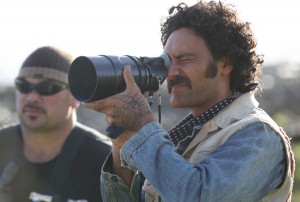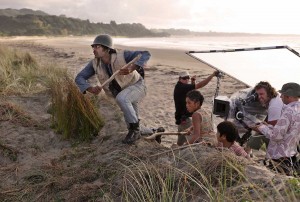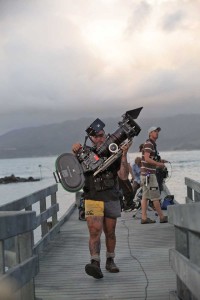
Set in a Maori community on the rural East Coast of New Zealand in 1984, the film is a heartfelt and hilarious coming-of-age tale about a dreamer who idolizes Michael Jackson at the height of the Thriller craze. That fascination with the pop star informs the fantasies that the 11-year-old boy, named Boy (James Rolleston), has about his absent father Alamein (Waititi). However, when the errant parent returns home after seven years, Boy’s beliefs that his father is a hero and adventurer are challenged by the reality that his ex-con parent is an inept, wannabe gangster, living in a fantasy world of his own.
The director grew up in a household like the one depicted in the film – many kids and not many adults – and although the film is not autobiographical, it draws upon his familiarity with the time period, close-knit community, and clearly defined locations. “I draw a lot of inspiration from true and imagined memories. This story is personal in that I believe you must write what you know in order to create honest art,” shares Waititi. “Some events are true, some true of other people, most are imagined.”
The film is shot in the very town where the director grew up. The interiors were filmed in his grandmother’s house, the actual house where the director lived. The exteriors were of his cousin’s house. “It is this amazing world that I wanted to capture and show on screen,” reveals Waititi. “It’s a perfect backdrop for this story.”

Two other favorite collaborators are producer Ainsley Gardiner and director of photography, Adam Clark. For a director that is also acting in the film, it is especially helpful to have an extra set of eyes on set. Regarding Gardiner, who has worked with Waititi on all of his films, Waititi says, “She is a very creative producer, on set all the time. She is a good person to have as an ally.”
Clark is a Canadian who has lived in New Zealand for 20 years. He has shot two shorts and two features for the director. “Adam is great because he is passionate about film. He doesn’t just clock in and clock out,” shares Waititi. “We would go and break into the camera truck on the weekends, steal the camera and go out and shoot landscapes and stuff for the day, just us two. It’s good to have people who really love the film and want it to be good.”
 Although the current trend in independent filmmaking is to shoot digitally, Waititi has always loved film and everything thing he has shot, except for television, has been shot on film. He has also shot a lot of still photography and explains, “I like the process and the way film looks. I think it looks better.” Clark is also a film purist, so if the director wanted to shoot digitally, he might not have been able to use his preferred cinematographer. In developing the visual style, the pair would talk a lot about “the look” for the film, watch films, and do tests for filters. Three or four different filters were used to warm up the film. “We were looking to give it that feel of a photo taken in the eighties,” Waititi explains.
Although the current trend in independent filmmaking is to shoot digitally, Waititi has always loved film and everything thing he has shot, except for television, has been shot on film. He has also shot a lot of still photography and explains, “I like the process and the way film looks. I think it looks better.” Clark is also a film purist, so if the director wanted to shoot digitally, he might not have been able to use his preferred cinematographer. In developing the visual style, the pair would talk a lot about “the look” for the film, watch films, and do tests for filters. Three or four different filters were used to warm up the film. “We were looking to give it that feel of a photo taken in the eighties,” Waititi explains.
The shooting schedule was 40 days over eight weeks. “It was very relaxed,” according to Waititi, partially because the kids could only work a limited number of hours each day.
The film had a traditional negative cut and color grade, although there were a couple of visual effects shots, like the sparklers, created digitally. Even the animation was done traditionally, shot “frame by frame, paper by paper” with an animation camera.
Costuming was by Amanda Neale. “She scoured the country, the second-hand stores, and found all these amazing clothes from thrift stores,” says Waititi. “Most of the people I work with were alive in the ’80s. They know the decade. They know the fashions, the styles and the designs.”
The film was edited digitally on Avid. The director did a lot of the cutting himself, along with editor Chris Plummer. Unlike many directors who work with the same editor on most of their pictures, Waititi generally likes to work with different editors on each project because, “I feel like each film is a different person. I felt like Chris, who was on Boy, was more suited for this film because he is more of a drama editor, where Eagle Versus Shark is more of a comedy.”
Editing is the most laborious process for Waititi, who prefers being around a lot of people and finds production more appealing than being in a room with one person. He has developed a specific editorial workflow based on getting different ideas of how to approach the film. After the film is edited, the director usually gives the main editor a break. He’ll work on the film a bit himself, then possibly work with a second, LA-based, editor, Yana Gorskaya. He elaborates, “Sometimes she doesn’t have anything to add to a scene and other times she might cut out all the dialog. It’s nice having someone else’s point of view.” Then he’ll “tinker” a bit more himself before bringing the original editor back to get their opinion for the last polish. In the end, his belief in regards to the best process is “whatever serves the story best.”
The local New Zealand band, The Phoenix Foundation, created the score for the film. They had done the director’s first film. Not only have they developed a creative shorthand gained through their previous work together, but there are no issues with ego. “I like working with friends really,” says Waititi. “Those guys were old friends from growing up.” The director loves trying different tracks and laying the music down. “That part is really fun, ” he says.
The production had money set aside to use Michael Jackson songs, including “Thriller”, but when they looked at the cut with the music, it didn’t feel right. “I think for a small film like this having a gigantic song like ‘Thriller’ or ‘Beat It’ might pull the audience out of the experience. It just felt like we needed to show those Michael Jackson moments with a little more honesty.”
His favorite part of the filmmaking process is being on-set, which Waititi says is somewhat like being “at camp.” Having a functioning crew composed of friends who work well together is of the utmost importance to him, “I don’t like working with anyone who’s got an ego. Otherwise you feel like turning up to set is going to be a trial because you have to deal with people who don’t get along. There is always someone who doesn’t like someone else. It’s like a school playground half the time.”





